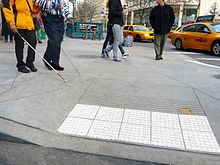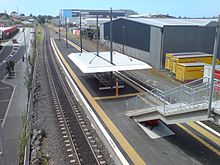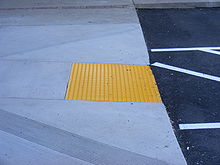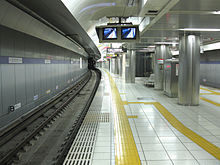- Tactile paving
-
Tactile paving (also called truncated domes, detectable warnings, Tactile Ground Surface Indicators, detectable warning surfaces) is a system of textured ground surface indicators found on many footpaths, stairs and train station platforms to assist blind and vision impaired pedestrians.
Tactile warnings provide a distinctive surface pattern of "truncated domes" or cones (which are small domes or cones that have had their tops cut off, or truncated) or "truncated bars" detectable by long cane or underfoot which are used to alert people with vision impairments of their approach to streets and hazardous drop-offs. People who are blind or visually impaired are alerted of impending danger from vehicle impact or a grade change. There is a disagreement in the design community and the community of users if the interior use of these bars represents a tripping hazard.
Originally instituted at crosswalks and other hazardous vehicular ways by countries like Japan, the United Kingdom and Australia, among others, the United States picked up the standard in the early 1990s, after passage of the Americans with Disabilities Act (ADA). Canada started incorporating the use in transportation first in the 1990s then added them to the built environment in early 2000s.
Contents
History
The original tactile paving was developed by Seiichi Miyake in 1965. The paving was first introduced in a street in Okayama city, Japan, in 1967. Its use gradually spread in Japan and then around the world.
Today yellow tactile pavings are almost ubiquitous throughout Japan. For aesthetic reasons, for example in front of hotels, the colour of the paving can change to reflect the colour of the pavement or stone floor. Sometimes the paving contours are with steel stripes and dots.
By country
In Australia
The Australian Human Rights and Equal Opportunity Commission (HREOC) released Guidelines on access to buildings and services in 2007, under the Disability Discrimination Act 1992. This recommends the use of Australian Standard AS/NZS 1428.4:2002 Design for access and mobility - Tactile indicators. The standard specifies the use of truncated cones, rather than domes (as used in the USA). HREOC describe the use of the standard.[1]
In Canada
In Canada detectable warning surfaces have in recent years started to be found in many provincial and municipal building standards (supplements to the building codes). These standards require detectable warning surfaces in prescribed locations, such as on the slopes of pedestrian curb cuts/curb ramps, exterior and interior ramps, at the top of stairs and on landings, and at the edge of rail platforms. Detectable warning surfaces include both truncated domes and tactile bars.
One of the first architectural standards for buildings requiring the use of detectable warning surfaces was the City of London Facility Accessibility Design Standards (FADS). The difference from the American ADA standards is the two different types of tactile surfaces required [3]. At stairs, detectable warning surfaces are required (long bars that in USA are called "directional bars" but are placed at perpendicular to the main path of travel), whereas offset truncated dome detectable warning surfaces are used for ramps, elevated platforms (like those found at the edges of boarding platforms in transit facilities), and at other areas where pedestrian ways blend with vehicular ways.
In the United States
 ADA compliant color contrast detectable warning installation on a high traffic area in New York City.
ADA compliant color contrast detectable warning installation on a high traffic area in New York City.
 Truncated dome tiles along the platform edge at the King Street – Old Town Metro train station in Alexandria, Virginia.
Truncated dome tiles along the platform edge at the King Street – Old Town Metro train station in Alexandria, Virginia.
In the U.S. tactile warnings systems are required by the ADA. The federal government, through studies and guidance provided by advocates and the Access Board[2] now mandates detectable warnings in prescribed locations, such as on the surface of pedestrian curb cuts and at the edge of rail platforms. Detectable warnings have been required for the edge of rail platforms in the United States since 1991. Detectable warnings for pedestrian curb cuts were suspended for study in 1994, and became officially required in 2001.
The ADA Accessibility Guidelines (ADAAG) require these warnings on the surface of curb ramps, which remove a tactile cue otherwise provided by curb faces, and at other areas where pedestrian ways blend with vehicular ways. They are also required along the edges of boarding platforms in transit facilities and the perimeter of reflecting pools. The raised pattern of domes also known as truncated domes are the preferred design for detectable warning tiles and pavers.
The usage of tactile paving in many circumstances will be required in the United States as part of the Americans with Disabilities Act.[3] Adoption of truncated dome-mats has been controversial in some areas including Sacramento, CA.[4]
Specifications for current enforceable ADA detectable warnings truncated domes regulation for the general public, is the United States Department of Justice 28 CFR part 36 Revised as of July 1, 1994.
Excerpt from ADA 4.3 Accessible Routes, 4.3.6 Surface Textures, 4.5 Ground Floor Surfaces, 4.5.3 - Carpet, 4.5.4 - Gratings - Textures. To date it appears none-of the detectable warnings manufactured, comply with 4.3.6 of the ADAAG. In addition, testing for being a non-hazardous surface placed in public walkways has not been conducted. In the appendix - some common sense reasons are illustrated about textures and their effects on the mobility impaired - A.4.5 Ground and Floor Surfaces. A4.5.1 General. People who have difficulty walking or maintaining balance or who use crutches, canes, or walkers, and those with restricted gaits are particularly sensitive to slipping and tripping hazards. For such people, a stable and regular surface is necessary for safe walking, particularly on stairs. Wheelchairs can be propelled most easily on surfaces that are hard, stable, and regular. Soft loose sand or gravel, wet clay, and irregular surfaces such as cobblestones can significantly impede wheelchair movement. 705 below has not been adopted by the DOJ for the general public and is therefore not enforced by the DOJ.
Specifications for ADA Detectable Warning Truncated Domes United States Access Board – ADAAG Specifies:
705 Detectable Warnings
705.1 General. Detectable Warnings shall consist of a surface of truncated domes and shall comply with 705.
705.1.1 Dome Size. Truncated domes in a detectable warning surface shall have a base diameter of 0.9 inch (23 mm) minimum and 1.4 inch (36 mm) maximum, a top diameter of 50 percent of the base diameter minimum to 65 percent of the base diameter maximum, and a height of 0.2 inch (5.1 mm).
705.1.2 Dome Spacing. Truncated domes in a detectable warning surface shall have a center-to-center spacing of 1.6 inches (41 mm) minimum and 2.4 inches (61 mm) maximum, and a base-to-base spacing of 0.65 inch (17mm) minimum, measured between the most adjacent domes on a square grid.
705.1.3 Contrast. Detectable Warning Surfaces shall contrast visually with adjacent walking surfaces either light-on-dark, or dark-on-light.
Standards
 High-contrast tactile pavers at Sylvia Park Train Station in New Zealand. Note the line of paving along the edges of the station platform, connecting to the push-button intercom bollard in the centre, and then past the stairs to the rear of the station where the elevator is located (out of sight).
High-contrast tactile pavers at Sylvia Park Train Station in New Zealand. Note the line of paving along the edges of the station platform, connecting to the push-button intercom bollard in the centre, and then past the stairs to the rear of the station where the elevator is located (out of sight).
- Australia / New Zealand AS/NZS 1428.4:2002 Design for access and mobility - Tactile indicators
- United Kingdom BS 7997:2003 Products for tactile paving surface indicators. Specification
- Japan JIS T 9251:2001 Dimensions and patterns of raised of parts of tactile ground surface indicators for blind persons
References
External links
- Federal Highway Administration: Detectable Warnings Memorandum
- United States Access Board: ADA Accessibility Guidelines, Detectable Warnings
- Canada City of London FADS
- External environments fact sheet
- [4]
- Mobility Research Centre New Zealand: Providing Innovative Tactile Solutions
Categories:- Accessible building
- Blindness
- Pedestrian crossing components
Wikimedia Foundation. 2010.


